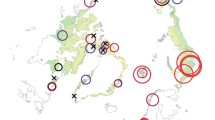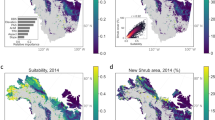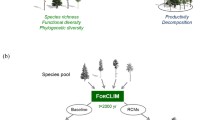Abstract
Encroachment of trees and shrubs into grasslands and the ‘thicketization’ of savannas has occurred worldwide over the past century. These changes in vegetation structure are potentially relevant to climatic change as they may be indicative of historical shifts in climate and as they may influence biophysical aspects of land surface-atmosphere interactions and alter carbon and nitrogen cycles. Traditional explanations offered to account for the historic displacement of grasses by woody plants in many arid and semi-arid ecosystems have centered around changes in climatic, livestock grazing and fire regimes. More recently, it has been suggested that the increase in atmospheric CO2 since the industrial revolution has been the driving force. In this paper we evaluate the CO2 enrichment hypotheses and argue that historic, positive correlations between woody plant expansion and atmospheric CO2 are not cause and effect.
Similar content being viewed by others
References
Archer, S.: 1989, ‘Have Southern Texas Savannas Been Converted to Woodlands in Recent History?’,Am. Nat. 134, 545–561.
Archer, S.: 1994, ‘Woody Plant Encroachment into Southwestern Grasslands and Savannas: Rates, Patterns and Proximate Causes’, in Vavra, M., Laycock, W., and Pieper, R. (eds.),Ecological Implications of Livestock Herbivory in the West, Soc. Range Manage., Denver, CO, pp. 13–68.
Archer, S., Scifres, C., Bassham, C., and Maggio, R.: 1988, ‘Autogenic Succession in a Subtropical Savanna: Rates, Dynamics and Processes in the Conversion of Grassland to Thorn Woodland’,Ecol. Monogr. 58, 111–127.
Bahre, C. J.: 1991,A Legacy of Change: Historic Human Impact on Vegetation of the Arizona Borderlands, Univ. Arizona Press, Tucson, 231 pp.
Baisan, C. H. and Swetnam, T. W.: 1990, ‘Fire History on a Desert Mountain Range: Rincon Mountain Wilderness, Arizona, USA’,Can. J. For. Res. 20, 1559–1569.
Bazzaz, F. A.: 1990, ‘The Response of Natural Ecosystems to the Rising Global CO2 Levels’,Ann. Rev. Ecol. Syst. 21, 167–196.
Branson, F. A.: 1985,Vegetation Changes on Western Rangelands, Range Monograph No. 2, Soc. Range Management, Denver, CO.
Brown, J. R. and Archer, S.: 1989, ‘Woody Plant Invasion of Grasslands: Establishment of Honey Mesquite (Prosopis glandulosa var. glandulosa) on Sites Differing in Herbaceous Biomass and Grazing History’,Oecologia 80, 19–26.
Bucher, E. H.: 1987, ‘Herbivory in Arid and Semi-Arid Regions of Argentina’,Rev. Chilena Histor. Natur. 60, 265–273.
Buffington, L. D. and Herbel, C. H.: 1965, ‘Vegetational Changes on a Semidesert Grassland Range from 1958 to 1963’,Ecol. Monogr. 35, 139–164.
Cole, D. R. and Monger, H. C.: 1994, ‘Influence of Atmospheric CO2 on the Decline of C4 Plants during the Last Deglaciation’,Nature 368, 533–536.
Conley, W., Conley, M. R. and Karl, T. R.: 1992, ‘A Computational Study of Episodic Events and Historical Context in Long-Term Ecological Processes: Climate and Grazing in the Northern Chihuahuan Desert’,Coenoses 7, 55–60.
Ehleringer, J.R. and Monson, R. K.: 1993, ‘Evolutionary and Ecological Aspects of Photosynthetic Pathway Variation’,Ann. Rev. Ecol. Syst. 24, 411–438.
Friedli, H., Lotscher, H., Oeschger, H., Siegenthaler, U., and Stauffer, B.: 1986, ‘Ice Core Record of13C/12C Ratio of Atmospheric CO2 in the Past Two Centuries’,Nature 324, 237–238.
Francey, R. J. and Hubick, K. T.: 1988, ‘Tree-Ring Carbon-Isotope Ratios Re-Examined’,Nature 333, 712.
Gardener, C. J., McIvor, J. G., and Williams, J.: 1990, ‘Dry Tropical Rangelands: Solving One Problem and Creating Another’, in Saunders, D. A., Hopkins, A. J. M., and How, R. A. (eds.),Australian Ecosystems, 200 Years of Utilization, Degradation and Reconstruction, Surrey, Beatty & Sons, Sydney, pp. 279–286.
Graumlich, L. J.: 1991, ‘Subalpine Tree Growth, Climate and Increasing CO2: An Assessment of Recent Growth Trends’,Ecology 72, 1–11.
Graumlich, L. J., Brubaker, L. B., and Grier, C. C.: 1989, ‘Long-Term Trends in Forest Net Primary Productivity: Cascade Mountains, Washington’,Ecology 70, 405–410.
Grover, H. D. and Musick, H. B.: 1990, ‘Shrub Land Encroachment in Southern New Mexico, USA: An Analysis of Desertification Processes in the American Southwest’,Clim. Change 17, 305–330.
Harrington, G. N.: 1991, ‘Effects of Soil Moisture on Shrub Seedling Survival in Semi-Arid Grassland’,Ecology 72, 1138–1149.
Harrington, G. N. and Hodgkinson, K. C.: 1986, ‘Shrub-Grass Dynamics in Mulga Communities of Eastern Australia’, in Joss, P. J., Lynch, P. W., and Williams, O. B. (eds.),Rangelands: A Resource under Siege, Australian Academy of Science, Canberra, pp. 26–28.
Harrington, G. N., Oxley, R. E., and Tongway, D. J.: 1979, ‘The Effects of European Settlement and Domestic Livestock on the Biological System in Poplar Box (Eucalyptus populnea) Lands’,Austral. Rangel. J. 1, 271–279.
Herbel, C. H., Ares, F. N., and Wright, R. A.: 1972, ‘Drought Effects on a Semi-Desert Grassland’,Ecology 53, 1084–1093.
Hunt, H. W., Trlica, M. J., Redente, E. F., Moore, J. C., Detling, J. K., Kittel, T. G. F., Walter, D. E., Fowler, M. C., Klein, D. A., and Elliott, E. T.: 1991, ‘Simulation Model for the Effects of Climate Change on Temperate Grassland Ecosystems’,Ecol. Model. 53, 205–246.
Idso, S. B.: 1992, ‘Shrubland Expansion in the American Southwest’,Clim. Change 22, 85–86.
Johnson, H. B., Polley, H. W., and Mayeux, H. S.: 1993, ‘Increasing CO2 and Plant-Plant Interactions: Effects on Natural Vegetation’,Vegetatio 104-105, 157–170.
La Marche, V. C., Jr., Graybill, D. A., Fritts, H. C., and Rose, M. R.: 1984, ‘Increasing Atmospheric Carbon Dioxide: Tree Ring Evidence for Growth Enhancement in Natural Vegetation’,Science 225, 1019–1021.
Madany, M. H. and West, N. E.: 1983, ‘Livestock Grazing-Fire Regime Interactions within Montane Forests of Zion National Park, Utah’,Ecology 64, 661–667.
Mayeux, H. S., Johnson, H. B., and Polley, H. W.: 1991, ‘Global Change and Vegetation Dynamics’, in James, L. F., Evans, J. O., Ralphs, M. H., and Sigler, B. J. (eds.),Noxious Range Weeds, Westview Press, Boulder, CO., pp. 62–74.
Mooney, H. A., Drake, B. G., Luxmore, R. J., Oechel, W. C., and Pitelka, L. F.: 1991, ‘Predicting Ecosystem Responses to Elevated CO2 Concentrations’,Bioscience 41, 96–104.
Morison, J. I. L.: 1993, ‘Response of Plants to CO2 under Water Limited Conditions’,Vegetatio 104-105, 193–209.
Neftel, A., Moor, E., Oeschger, H., and Stauffer, B.: 1985, ‘Evidence from Polar Ice Cores for the Increase in Atmospheric CO2 in the Past Two Centuries’,Nature 315, 45–47.
Neilson, R. P.: 1986, ‘High Resolution Climatic Analysis and Southwest Biogeography’,Science 232, 27–34.
Owensby, C. E., Coyne, P. I., Ham, J. M., Auen, L. M., and Knapp, A. K.: 1993, ‘Biomass Production in a Tall Grass Prairie Ecosystem Exposed to Ambient and Elevated CO2’,Ecol. Appl. 3, 644–653.
Polley, H. W., Johnson, H. B., and Mayeux, H. S.: 1992, ‘Carbon Dioxide and Water Fluxes of C3 Annuals and C3 and C4 Perennials at Subambient CO2 Concentrations’,Function. Ecol. 6, 693–703.
Polley, H. W., Johnson, H. B., and Mayeux, H. S.: 1994, ‘Increasing CO2: Comparative Responses of the C4 GrassSchizachyriuim and Grassland InvaderProsopis’,Ecology 75, 976–988.
Poorter, H.: 1993, ‘Interspecific Variation in the Growth Response of Plants to an Elevated Ambient CO2’,Vegetatio 104-105, 77–97.
Prentice, I. C.: 1986, ‘Vegetation Responses to Past Climatic Variation’,Vegetatio 67, 131–141.
Riechers, G. D. and Strain, B. R.: 1988, ‘Growth of Blue Grama (Bouteloua gracilis) in Response to Atmospheric Carbon Dioxide Enrichment’,Canad. J. Bot. 66, 1570–1573.
Savage, M. and Swetnam, T. W.: 1990, ‘Early 19th-Century Fire Decline Following Sheep Pasturing in a Navajo Ponderosa Pine Forest’,Ecology 71, 2374–2378.
Schlesinger, W. H., Reynolds, J. F., Cunningham, G. L., Huenneke, L., Jarrell, W. M., Virginia, R. A., and Whitford, W. G.: 1990, ‘Biological Feedbacks in Global Desertification’,Science 247, 1043–1048.
Schofield, C. J. and Bucher, E. H.: 1986, ‘Industrial Contributions to Desertification in South America’,Trends Ecol. Evol. 1, 78–80.
Skarpe, C.: 1991, ‘Impact of Grazing in Savanna Ecosystems’,Ambio 20, 351–356.
Smeins, F. E. and Merrill, L. B.: 1988, ‘Long-Term Change in Semi-Arid Grassland’, in Amos, B. B. and Gehlbach, F. R. (eds.),Edwards Plateau Vegetation, Baylor Univ. Press, Waco, TX, U.S.A., pp. 101–114.
Stoddart, L. A., Smith, A. D., and Box, T. W.: 1975,Range Management, McGraw Hill, New York, 532 p.
Swetnam, T. W. and Betancourt, J. L.: 1990, ‘Fire-Southern Oscillation Relations in the Southwestern United States’,Science 249, 1010–1020.
USDA: 1989, ‘Livestock and Meat Statistics’,Statistical Bulletin 784, U.S. Dept. Agriculture, Agricultural Marketing Service, Washington, DC.
Van Devender, T. R.: 1980, ‘Holocene Plant Remains from Rocky Arroyo and Last Chance Canyon, Eddy County, New Mexico’,Southwest. Nat. 25, 361–372.
Van Devender, T. R. and Spaulding, W. G.: 1979, ‘Development of Vegetation and Climate in the Southwestern United States’,Science 204, 701–710.
Van Vegten, J. A.: 1983, ‘Thornbush Invasion in a Savanna Ecosystem in Eastern Botswana’,Vegetatio 56, 3–7.
Young, J. A. and Evans, R. A.: 1981, ‘Demography and Fire History of a Western Juniper Stand’,J. Range Managem. 34, 501–506.
Author information
Authors and Affiliations
Additional information
Please direct all correspondence to the senior author.
Rights and permissions
About this article
Cite this article
Archer, S., Schimel, D.S. & Holland, E.A. Mechanisms of shrubland expansion: land use, climate or CO2?. Climatic Change 29, 91–99 (1995). https://doi.org/10.1007/BF01091640
Received:
Revised:
Issue Date:
DOI: https://doi.org/10.1007/BF01091640




